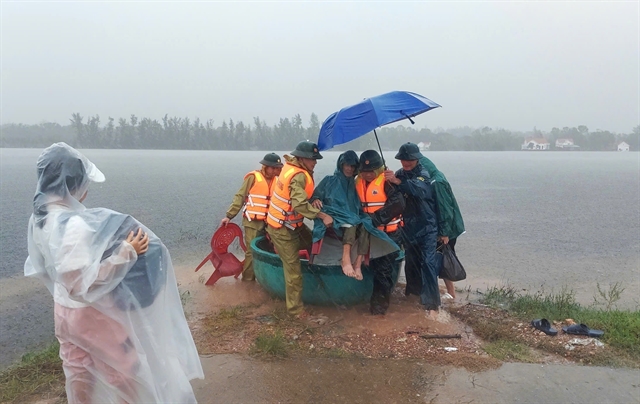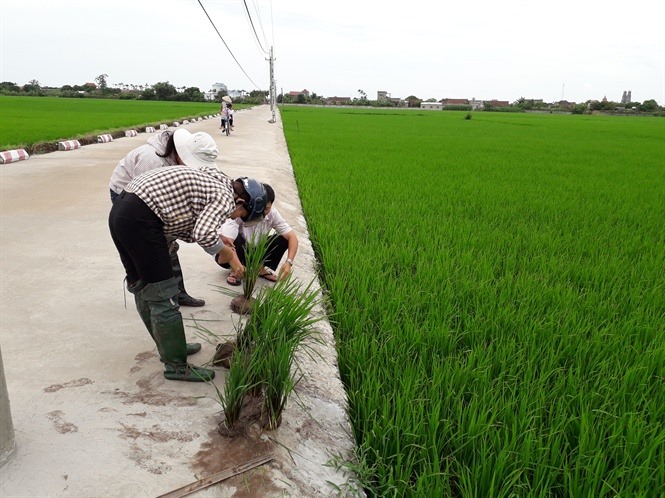 Society
Society

Hoàng Đức Lợi, a farmer from Trực Cường Commune in Nam Định Province’s Trực Ninh District, felt despair when seeing his rice fields being hit by a disease that would cause him total loss this year.
 |
| Farmers in Giao Thuỷ District, Nam Định Province, examine infected rice plants they have pulled out of the field. — Photo nongnghiep.vn |
NAM ĐỊNH – Rice farmer Hoàng Đức Lợi is in deep despair.
The resident of Trực Cường Commune in Nam Định Province’s Trực Ninh District is afraid that he will lose his crop completely to disease.
“The plants are wilting, the leaves are stiff and there’s no sprouting (of grains),” Lợi said.
With VNĐ50 million (US$2,200) invested in each hectare, he stands to lose VNĐ200 million ($4,800) on this crop, which has been hit by the “southern rice black-streaked dwarf virus” that has been ravaging rice fields in the country since the beginning of July, according to the Ministry of Agriculture and Rural Development (MARD).
Many farmers have suffered huge losses already, the Ministry has said.
Bùi Sĩ Doanh, deputy head of the ministry’s Plant Protection Department, said the disease caused by the virus has spread to more than 40,000 hectares in the country, 155 times higher than the affected area during the same period last year.
Doanh said the many reason for the widespread damage was the high density of white-backed plant hoppers that transmit the virus. The virus stunts the plants’ growth and stops them from “heading,” which is when pollination occurs. Badly affected plants wither and die.
In 2009, this disease had spread to 19 provinces in northern Việt Nam, where it had damaged 42,000ha of rice. In 2010, more than 60,000ha fields in 29 provinces were damaged by the same virus.
Nguyễn Huy Điền, deputy director of Nam Định Department of Agriculture and Rural Development, said 16,000ha of rice fields in the province have been affected by the disease. Of this, 8,000ha have been seriously infected and some 4,000ha might be totally lost, he added.
What is more worrying, Điền said, is that the areas of seriously affected rice fields could continue to rise in the coming time because Nam Định still has some 10,000ha of rice fields that have not come to the heading stage, the time when the disease’s symptoms are more visible.
Weather and carelessness
Điền said weather was the main cause for the current situation, but Trần Mạnh Báo, President of the Việt Nam Seed Trade Association, thought otherwise.
“The negligence of localities in disease prevention is the main cause for such extensive damage. Farmers should have been guided on preventive measures in the early stage, but they were not. So the virus, which has been appearing in Viet Nam since 2009, had the chance to come back strongly,” Báo said.
A plant protection expert who wanted to remain unnamed said weather was of course a facilitator for the disease, but the situation could have been better controlled.
“Theoretically, getting rid of the white-backed planthoppers for the sake of preventing the southern rice black-streaked dwarf virus is a totally different exercise from the common practice of using pesticides,” he told the Nông nghiệp Việt Nam (Việt Nam Agriculture) online newspaper.
“Normal application of pesticides will help farmers keep the planthoppers’ density under 20 per metre, but if the aim is to kill the virus, we can’t afford such density, because even at the rate of five per metre, the virus can cause severe damage to the rice fields,” he said.
Farmer Lợi said the situation cannot be managed without expert help.
“How do we know which white-backed planthopper carries virus and which does not? If we act on our own on seeing some insects, the fields would become a huge sea of pesticides,” he said.
Nam Định officials said they have conducted field visits to affected areas and provided some guidance to farmers on how to control the spread of the disease.
Farmers in Thái Bình Province are also suffering, with more than 18,000ha infected with the virus. According to unofficial statistics from districts in the province, some 2,400ha have been totally ruined.--VNS




